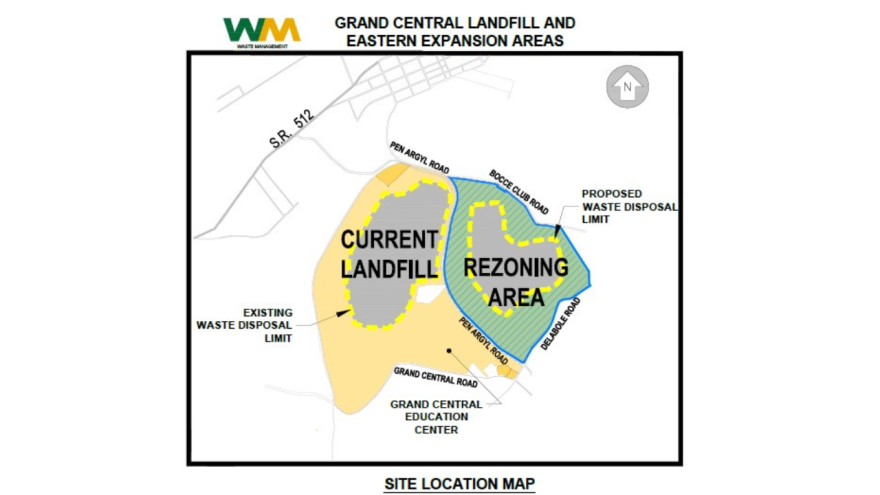PLAINFIELD TWP., Pa. — Despite a few concerns, a proposal to expand a landfill in Plainfield Township was approved Tuesday by Lehigh Valley Planning Commission's Comprehensive Planning Committee.
The application would see the Grand Central Landfill East consolidate 18 parcels in a 210.9-acre lot, expanding the existing landfill at 1963 Pen Argyl Road.
The landfill itself would encompass about 95 acres.
LVPC Environmental Planner Corinne Ruggiero said the land to the northern half of the project site is designated as exurban, which is "generally lacking the characteristics necessary to support new development and are intended to remain in rural uses.”
However, that the land sits adjacent to an existing waste site, with that area previously accommodating that type of land use.
“The proposal facilitates the continued operation of a regionally significant landfill, which provides environmentally responsible and economical waste disposal."Lehigh Valley Planning Commission Environmental Planner Corinne Ruggiero
Land to the south of the site is designated as farmland preservation, Ruggiero said, and includes high and medium conservation priority natural features.
Those include woodlands to the north and southeast, steep slopes to the south and wetlands along Waltz Creek to the east.
“The proposal facilitates the continued operation of a regionally significant landfill, which provides environmentally responsible and economical waste disposal," Ruggiero said.
"And it also promotes the fiscal health and sustainability of municipalities.
“Maintaining local solid waste disposal capacity provides opportunities to reduce the need for long-distance waste transport, which helps limit associated emissions from hauling vehicles and supports long term fiscal sustainability through continued host fees and service sustainability.”
Environmental impacts
But the proposal poses a number of environmental effects, LVPC Director of Environmental Planning Susan Myerov said.
Current plans show the landfill about 100 feet from delineated wetlands, while the LVPC recommended separating the areas by at least 150 feet.
LVPC also recommended preserving natural resources in the land development process by reducing extent of the landfill area to avoid the disturbance of steep slopes and of woodland loss.
“The LVPC recommends the township pursue assurances that the proposed landfill area will not encroach on surrounding natural resources in the future,” Myerov said.
“This can be accomplished by a land protection tool, such as conservation easement land dedication or memorializing agreements in the notes on recorded plans as to the limits of disposal.”
Myerov also said the landscaping plan for the project should include a detailed summary of the trees on the property that may be removed, and a proposal for replacement of those trees, with input from a licensed landscape architect on the landscape plan.
Additional recommendations included maintaining a street tree requirement along the property’s road frontage because of existing trees, prioritizing native and climate-resilient plants for new planting, and ensuring all tree removal complies with the township’s zoning ordinance.
Studying traffic
LVPC Chief Community and Regional Planner Jill Seitz reviewed a traffic impact study conducted on the site, with the current setup generating 177 trips per day.
The TIS showed the expansion would not increase trip traffic.
"Deterioration of the local road network due to heavy vehicle use over extended periods of time could necessitate detours, weight restrictions or repair projects that would affect residents and businesses.”Lehigh Valley Planning Commission Chief Community and Regional Planner Jill Seitz
“The project site is not located near major corridors," Seitz said. "LVPC strongly recommends that the applicant be required to prepare a truck routing and infrastructure viability plan to identify critical transportation and structure necessary for the safe and efficient operation of the facility.
“Maintaining the long-term viability of roadway assets is essential to both the project and surrounding communities. Deterioration of the local road network due to heavy vehicle use over extended periods of time could necessitate detours, weight restrictions or repair projects that would affect residents and businesses.”
Other recommendations included potential electric vehicle charging stations and installing on-site snow removal facilities on the property.
Also, having the township look into a study on interactions behind drivers and pedestrians, and exploring the potential for a Lehigh and Northampton Transportation Authority route to the site to accommodate employees.
Also, establishing coordination between local first responders and the township to ensure rapid response to emergencies, minimizing the environmental impact to the area, and sharing information among local municipalities to help mitigate those impacts.
'Forcefully encouraging' protection
John Gallagher said that while he recognized the LVPC exists as an advisory group, he wished there was a way to “forcefully encourage” the township to provide the advised protections.
“We can strengthen it, or at least make stronger suggestions,” Gallagher said.
“We run across this all the time… in an advisory role, you know, we can only suggest things, and if there are ways to reinforce that language so that these protected areas actually, in the long term, over time, will remain protected, that's the responsibility of the township.”
LVPC Executive Director Becky Bradley said the commission would act as a regulatory agency if a stormwater review on the site is required.
“Depending on which watershed or watersheds a project is in, because it could be more than one, we would be regulatory there,” Bradley said.
“But that stuff… that's handled by the professional engineers in the office, per statute, and they provide additional comment, in addition to the advisory review that we do here on the development plan itself, the non-stormwater components of the development plan.”
Steve Melnick proposed arranging the environmental evaluations to take place every six months or once a year to ensure consistent review of the site.
Bradley repeated that the LVPC could offer suggest as much to the township.
Melnick also asked about whether The Green Knight Energy Center, which collects methane gas at the landfill and uses it to generate electricity for about 8,000 homes, was consulted on the expansion.
Waste Management Community Relations Specialist Adrienne Fors confirmed the Green Knights were working with Waste Management and were aware of the expansion project.
Fors also acknowledged that a zoning ordinance amendment for the site, which the LVPC approved just before the land use of regional significance review, came from a proposal from previous township officials.
“They’re essentially looking at this from administrative approach, I believe," Fors said. "So we are not changing our tonnage for this expansion. Everything is staying the same."
The LVPC voted unanimously in favor of the measure.


